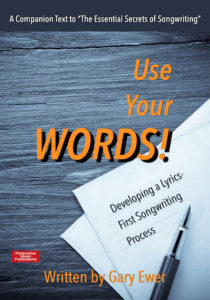Most of the time, you write songs where all the sections (verse, chorus, etc.) are written as part of the same process. You might write a chorus hook, and then you work on a verse that will partner well with it, and so on.
But you likely have bits of songs that you’ve written over the years that never found a home in a complete song. Those individual parts might sound great, but you just never found a way of working them into a song.
 Trying to get a handle on writing song lyrics? Discover the benefits of making a lyrics-first method your new go-to process with”Use Your Words! Developing a Lyrics-First Songwriting Process. It’s FREE right now when you purchase the 10-eBook Bundle.
Trying to get a handle on writing song lyrics? Discover the benefits of making a lyrics-first method your new go-to process with”Use Your Words! Developing a Lyrics-First Songwriting Process. It’s FREE right now when you purchase the 10-eBook Bundle.
If you’ve got several or more of these abandoned ideas sitting in a proverbial drawer somewhere, it might be time to pull some of them together and see if you can make completed songs out of them.
You might wonder — How can parts of songs, written at different times, wind up working together within the same song? It really comes down to knowing the basic principles of good songwriting. As long as the various sections, which might have been written months — maybe even years — apart, exhibit the qualities of what that section typically shows, your audience will usually be none the wiser.
So what are the things you should keep in mind and remember as you start pulling these various parts together? Here are some tips:
- Choose sections and then move them into the same, or closely related, keys. Most songs will keep a constant key throughout, but remember that a verse will often be in minor, moving to major for a chorus. So if you pull out a verse you wrote last month that’s in A minor, your chorus will likely work if it’s in either A minor or C major – the relative major.
- Make note of the basic range of each section. One of the most important considerations for what makes a verse sound like a verse, for example, is that it usually sits lower in pitch than the chorus. So if you find a section you wrote a while back, but it’s pitched rather high, you may get the verse-like quality you’re looking for by lowering it, especially relative to the chorus you’re going to pair it with.
- Try each section with a similar backing rhythm approach. Most choruses will build on the rhythmic approach that gets set up in the verse. The parts you’re trying to pull together might have rather different rhythmic feels, and so creating a backing rhythm feel that is related will help give you a clearer picture of what they’d sound like in the same song.
- Don’t consider lyrics yet. Getting a lyric that works can wait until you get the music working. This is not to say that lyrics are unimportant. But if these musical ideas were originally written at different times, you’ll need to eventually rework one or both of the lyrics that you originally wrote. Getting the sections together is mostly a musical task, and that should happen first.
And remember that you can use small bits of the sections you originally wrote. You may find a chorus section that you wrote a while ago, but maybe it’s just the first few notes you really like. But those few notes might be all you need to restart the writing process for the rest of the song.
It can be exciting to hear two sections come together in this way, when you probably thought you had written something that was never going to see the light of day. Audiences can find the truth of the matter quite interesting if you choose to tell them. As long as the different sections partner well, that’s all that really matters.
 Written by Gary Ewer. Follow on Twitter.
Written by Gary Ewer. Follow on Twitter.
 Have a great melody, but stuck at the “how to add chords to it” stage? “How To Harmonize a Melody” shows you, step-by-step and with sound samples, how it’s done, with suggestions for chord substitutions that might work as well. It’s part of “The Essential Secrets of Songwriting” 10-eBook Bundle.
Have a great melody, but stuck at the “how to add chords to it” stage? “How To Harmonize a Melody” shows you, step-by-step and with sound samples, how it’s done, with suggestions for chord substitutions that might work as well. It’s part of “The Essential Secrets of Songwriting” 10-eBook Bundle.










